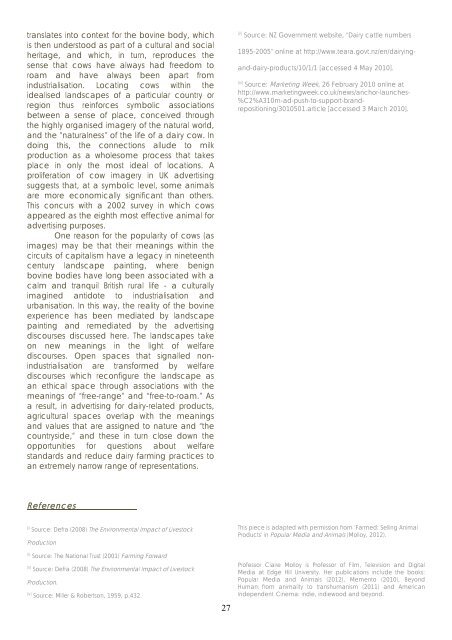Marketing Animals - Antennae The Journal of Nature in Visual Culture
Marketing Animals - Antennae The Journal of Nature in Visual Culture
Marketing Animals - Antennae The Journal of Nature in Visual Culture
Create successful ePaper yourself
Turn your PDF publications into a flip-book with our unique Google optimized e-Paper software.
translates <strong>in</strong>to context for the bov<strong>in</strong>e body, which<br />
is then understood as part <strong>of</strong> a cultural and social<br />
heritage, and which, <strong>in</strong> turn, reproduces the<br />
sense that cows have always had freedom to<br />
roam and have always been apart from<br />
<strong>in</strong>dustrialisation. Locat<strong>in</strong>g cows with<strong>in</strong> the<br />
idealised landscapes <strong>of</strong> a particular country or<br />
region thus re<strong>in</strong>forces symbolic associations<br />
between a sense <strong>of</strong> place, conceived through<br />
the highly organised imagery <strong>of</strong> the natural world,<br />
and the ”naturalness” <strong>of</strong> the life <strong>of</strong> a dairy cow. In<br />
do<strong>in</strong>g this, the connections allude to milk<br />
production as a wholesome process that takes<br />
place <strong>in</strong> only the most ideal <strong>of</strong> locations. A<br />
proliferation <strong>of</strong> cow imagery <strong>in</strong> UK advertis<strong>in</strong>g<br />
suggests that, at a symbolic level, some animals<br />
are more economically significant than others.<br />
This concurs with a 2002 survey <strong>in</strong> which cows<br />
appeared as the eighth most effective animal for<br />
advertis<strong>in</strong>g purposes.<br />
One reason for the popularity <strong>of</strong> cows (as<br />
images) may be that their mean<strong>in</strong>gs with<strong>in</strong> the<br />
circuits <strong>of</strong> capitalism have a legacy <strong>in</strong> n<strong>in</strong>eteenth<br />
century landscape pa<strong>in</strong>t<strong>in</strong>g, where benign<br />
bov<strong>in</strong>e bodies have long been associated with a<br />
calm and tranquil British rural life - a culturally<br />
imag<strong>in</strong>ed antidote to <strong>in</strong>dustrialisation and<br />
urbanisation. In this way, the reality <strong>of</strong> the bov<strong>in</strong>e<br />
experience has been mediated by landscape<br />
pa<strong>in</strong>t<strong>in</strong>g and remediated by the advertis<strong>in</strong>g<br />
discourses discussed here. <strong>The</strong> landscapes take<br />
on new mean<strong>in</strong>gs <strong>in</strong> the light <strong>of</strong> welfare<br />
discourses. Open spaces that signalled non<strong>in</strong>dustrialisation<br />
are transformed by welfare<br />
discourses which reconfigure the landscape as<br />
an ethical space through associations with the<br />
mean<strong>in</strong>gs <strong>of</strong> “free-range” and “free-to-roam.” As<br />
a result, <strong>in</strong> advertis<strong>in</strong>g for dairy-related products,<br />
agricultural spaces overlap with the mean<strong>in</strong>gs<br />
and values that are assigned to nature and “the<br />
countryside,” and these <strong>in</strong> turn close down the<br />
opportunities for questions about welfare<br />
standards and reduce dairy farm<strong>in</strong>g practices to<br />
an extremely narrow range <strong>of</strong> representations.<br />
References<br />
[i] Source: Defra (2008) <strong>The</strong> Environmental Impact <strong>of</strong> Livestock<br />
Production<br />
[ii] Source: <strong>The</strong> National Trust (2001) Farm<strong>in</strong>g Forward<br />
[iii] Source: Defra (2008) <strong>The</strong> Environmental Impact <strong>of</strong> Livestock<br />
Production.<br />
[iv] Source: Miller & Robertson, 1959, p.432.<br />
27<br />
[v] Source: NZ Government website, “Dairy cattle numbers<br />
1895-2005” onl<strong>in</strong>e at http://www.teara.govt.nz/en/dairy<strong>in</strong>g-<br />
and-dairy-products/10/1/1 [accessed 4 May 2010].<br />
[vi] Source: <strong>Market<strong>in</strong>g</strong> Week, 26 February 2010 onl<strong>in</strong>e at<br />
http://www.market<strong>in</strong>gweek.co.uk/news/anchor-launches-<br />
%C2%A310m-ad-push-to-support-brandreposition<strong>in</strong>g/3010501.article<br />
[accessed 3 March 2010].<br />
This piece is adapted with permission from ‘Farmed: Sell<strong>in</strong>g Animal<br />
Products’ <strong>in</strong> Popular Media and <strong>Animals</strong> (Molloy, 2012).<br />
Pr<strong>of</strong>essor Claire Molloy is Pr<strong>of</strong>essor <strong>of</strong> Film, Television and Digital<br />
Media at Edge Hill University. Her publications <strong>in</strong>clude the books:<br />
Popular Media and <strong>Animals</strong> (2012), Memento (2010), Beyond<br />
Human:xfrom animality to transhumanism (2011) and American<br />
IndependentxC<strong>in</strong>ema: <strong>in</strong>die, <strong>in</strong>diewood and beyond.












